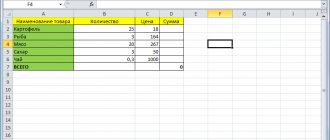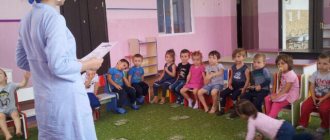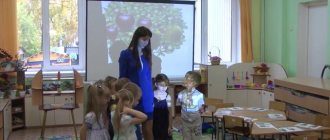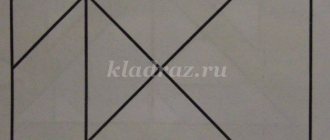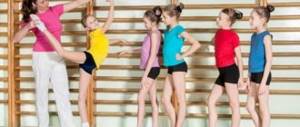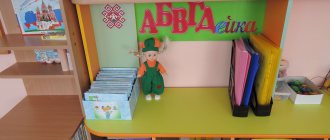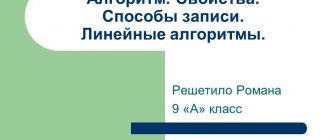(Lessons: No. 6, No. 12, No. 19, No. 23)
Knowledge must serve the creative purposes of man.
It is not enough to accumulate knowledge; they need to be disseminated and applied as widely as possible. ON THE. Rubakin
- Generalization and systematization are an integral property of mental activity, underlying the establishment of relationships between the phenomena being studied, and scientific knowledge in general.
A head filled with fragmentary, incoherent knowledge is like a storeroom in which everything is in disarray, and where the owner himself will not find anything; the head, where there is only a system without knowledge, is like a shop in which all the drawers have inscriptions, but the drawers are empty.
K.D. Ushinsky
- In the technology of activity-based teaching method L.G. Peterson, generalization and systematization
of students’ knowledge is a mandatory component of education, which ensures the formation of a systematic knowledge, skills and abilities of students. Generalization is carried out not only at each lesson (at the stage of updating knowledge, at which students generalize the knowledge necessary to discover something new, and at the stage of inclusion in the knowledge system), but also at special lessons: lessons of generalization and systematization of knowledge.
- In the “World of Activity” course, lessons on generalizing and systematizing knowledge: “I am a student: what I already know and can do”
are held at the end of each quarter.
These lessons are built on the basis of the basic structure of a reflection lesson
and form in children
the primary experience of identifying existing difficulties and their causes, setting goals for correctional activities, self-control and self-esteem
.
- The main objectives of these lessons:
- Summarize and systematize the knowledge discovered in previous lessons in the “World of Activities” program.
- Summarize the accumulated experience in applying this knowledge and identify existing difficulties.
- Outline prospects for further correction of identified difficulties in lessons in various academic subjects.
- To organize lessons in the “World of Activity” course, there is a section “Test yourself
,” which is located at the end of the textbook:
Self-control
Students can follow both the samples presented in class by the teacher and the samples in the “Test yourself” section. The teacher can organize work with this section during a general lesson to conduct a self-test using the sample. It is advisable to organize work with this section also with students who have missed one or another topic of the course.
- After each general lesson, the teacher can organize individual work to correct the difficulties
of each student, both in lessons on the course “World of Activities” and in subject lessons.
- The first generalization lesson
in first grade is held after
lesson No. 5
.
The main objective of the lesson is to summarize the children’s knowledge acquired in the first quarter
of the “World of Activities” course and the ability to apply it in educational activities.
Taking into account the age characteristics of the students, the storyline of the lesson revolves around a journey with the girl Alice to the country of Through the Looking Glass. The result of each student’s work in the lesson is recorded in a fabulous “Mirror”
, which will create an atmosphere of psychological comfort in the lesson.
Drawing an analogy with a mirror (when you look in the mirror, you see what is wrong with you, and you can correct it), students are calm about their mistakes, realizing that they can be corrected. At the updating stage, students repeat only the knowledge and skills that they discovered and applied in all lessons in the first quarter. To do this, the teacher hangs on the board numbered standards for all covered topics from lessons No. 1–5
, among them are two unfamiliar standards from
lessons No. 9
and
No. 20
. Students choose the necessary standards, knowledge and skills with which they will work in this lesson.
During the lesson, the teacher records difficulties
children and includes work with appropriate standards
in the following lessons
in the course “World of Activity” and
in subject lessons
conducted using the technology of the activity-based teaching method.
- The second general lesson
is held after
the 11th lesson at the end of the second quarter
.
In this lesson, students take a trip with fairy-tale characters to the workshop of Santa Claus. When completing assignments in class, students record the results of their work on a Christmas tree
.
The main objective of this lesson is to summarize the children’s knowledge acquired in the second quarter
in the course “World of Activities”, and the ability to apply them in educational activities. For updating, the teacher offers students numbered names of standards from the lessons of the second quarter, as well as two names of standards from the lessons of the first quarter and one standard from the third quarter:
- "Look at the blackboard. Select the benchmarks you have studied this quarter.”
Students name the standards “How to be attentive in class”, “Difficulty is my assistant in learning”, “Health in learning activities”, “Rules for working in groups”, “Patience in learning activities”.
When conducting a lesson, the goal is not to complete all tasks in one lesson. The teacher can either select three or four standards for repetition in a given lesson
, which cause the greatest difficulties for students, either split this lesson into two using reserve lessons, or assign some tasks in the afternoon, or create your own scenario and come up with your own tasks.
- The main task of the third
generalizing lesson is to summarize the children’s knowledge acquired in
the third quarter
of the “World of Activities” course and the ability to apply it in educational activities.
Just like all generalization lessons, this lesson is built on the basis of the basic structure of a reflection lesson and continues to form in students the initial experience of reflecting on their activities, self-control and self-esteem.
In this lesson, children make an exciting journey with Smiley into the spring forest.
When completing assignments in class, students record the results of their work on a postcard with a chamomile
, which they take home as a gift. When conducting a lesson, as before, the goal is not to complete all the tasks in one lesson. The teacher can either select 3-4 standards for repetition in a given lesson that cause the greatest difficulties for students, or split this lesson into two using reserve lessons, complete some tasks in the afternoon, etc.
At the actualization stage, the teacher sets the task for students:
- “In order for our journey to take place, you need to remember all the topics of the third quarter. You practiced this knowledge in all lessons, noting your results in the “Treasury of Achievements.” Now name them. (“How to find out what I don’t know”, “Why does a student need homework”, “Family is my assistant in learning”, “Test action”, “I’ll stop to think”, “The reason for the difficulty.”)”
- The main task of the final
generalization lesson is
to repeat the main topics covered during the year
in the course “World of Activities” in 1st grade.
This lesson lasts 1 hour and is intended to be open to parents.
Parents can become active participants.
To do this, some of the parents (or all parents, if class space allows) can be placed in groups with the children.
The lesson is conducted in the form of an expedition
through the ocean “Test Action”, the island “Difficulty”, the mountain “Cause” to its peak “Purpose” in order to find
a message from second graders
about what will be studied in the 2nd grade in the course “World of Activity”. It is advisable to distribute children and parents into groups so that the groups are equal in capabilities. The teacher can prepare in advance a wall newspaper, slide show or video clips from the “World of Activities” lessons held over the year, involving students and parents for this.
In the "Additional materials"
contains logical problems, words to songs about school and friendship, which can be included in the lesson script.
The lesson culminates in writing a message for future first-graders
who will study the course “World of Activity”. At the end of the lesson, it is advisable to present souvenirs or certificates from Smiley to all students in the class.
- It should be borne in mind that the proposed lesson scenarios are only one of many possible options; this is only “source material” that is designed to help the teacher create HIS OWN LESSON.
A teacher is a person who can make difficult things easy.
R. Emerson
Good luck to you and creative success!
“I am a student” (workshop conversation)
It was the father, noticing his son’s passion for art, who began to write out special articles and biographies of famous artists for him. It was he who, having decided his fate, sent the young man to Moscow in 1852 to study at the School of Painting and Sculpture.
Shishkin thought about the artistic “field” early on. For four years spent in his father’s house after his “escape” from Kazan (1848-52), he kept notes in which he seemed to guess his future life. We quote: “An artist must be a supreme being, living in an ideal world of art and striving only for improvement. Characteristics of an artist: sobriety, moderation in everything, love of art, modesty of character, conscientiousness and honesty.”
From 1852 to 1856, Shishkin studied at the recently opened (in 1843) Moscow School of Painting and Sculpture. His mentor was A. Mokritsky, a thoughtful and attentive teacher who helped the aspiring painter find himself. In 1856, Shishkin entered the St. Petersburg Academy of Arts.
At the Academy, Shishkin stood out noticeably for his talents; his successes were celebrated with medals; in 1860 he graduated from the Academy with a large gold medal, received for two paintings “View on the island of Valaam. Locality of Cucco" and gave the right to an internship abroad. But he was in no hurry to go abroad, instead going to Yelabuga in 1861. In his native places, Shishkin worked tirelessly.
The third journey.
Work abroad.
From 1862 to 1865, Shishkin lived abroad - mainly in Germany and Switzerland, while visiting the Czech Republic, France, Belgium and Holland. In Düsseldorf, he painted a lot in the Teutoburg Forest and was extremely popular among the local residents. He himself ironically recalled: “Wherever and wherever you go, they show everywhere that this Russian has gone, even in stores they ask if you are the Russian Shishkin who draws so magnificently?”
The fourth journey. Shishkin's creativity.
In 1836, a group of young realist specialists led by I. Kramskoy left the Academy with great noise, refusing to paint a picture on a given topic. "Rebels" founded the Artel of Artists. Shishkin became close to this Artel in the late 1860s.
From the Artel in 1870 the Partnership of Traveling Art Exhibitions grew, which became a symbol of the new artistic era. Shishkin was one of its founders. He never betrayed the ideals of the Itinerant movement, participating in every traveling exhibition until his death in 1898. The artist developed a particularly close relationship with I. Kramskoy, one of the most active “advertisers” of Shishkin’s work. It was Kramskoy who said the most precise words about Shishkin: “When he is in front of nature, he is exactly in his element, here he is bold and does not think about how, what and why; This is the only person we have who knows nature in a scientific way.” Kramskoy even provided Shishkin with his own workshop when he was preparing his work “Midday” for an academic exhibition. In the vicinity of Moscow" (1869), with which, in fact, the artist’s fame began. This was the first Shishkin painting acquired by P. Tretyakov.
Summary of extracurricular activity “Who am I? What am I?"; 1 class
This summary can be used for extracurricular activities, class hours on the topic “Who am I?” What am I?
This lesson has the following goal: to help children understand themselves and those around them. During the lesson, the children will learn that a person is a piece of nature, that a person has different moods and this mood can often be recognized by facial expressions. Children are also trying to answer the question of what a bad and a good person means. This lesson is aimed at 1st grade students.
Goal: to help children understand themselves and those around them.
Tasks:
- introduce children to new concepts and systematize existing knowledge;
- develop thinking, introspection, curiosity;
- to cultivate self-criticism and emotionality in children.
Equipment: drawing of a man, mood petals, cards with the words “bad”, “good”, “what do I have?”, “memory”, “feelings”, “mood”, “speech”, facial drawings, tokens.
First, let's play.
“Dot, dot, comma, a crooked face came out; stick, stick, cucumber - so the little man came out. - Guys, who is this person? (this is me.) - That's right, this is us, living beings, this is nature. What kind of person is there? How do you think? - Yes, a person can be good and bad. (Cards with words.) - Guys, what kind of person is called bad? Which one is good? - So a person can be good and bad. What qualities did a good person have? What kind of bad person are you? - Now close your eyes and ask yourself: “Who am I?” - Yes, of course a man. Man is a particle of nature, a living being. But how does a person differ from other creatures: from plants, insects, animals? What do we have? Why do we remember our apartment number or can recite a poem? - Why do we rejoice at good news and are sad when it fails? - Why are we sometimes cheerful and sometimes sad? - Now we will build a mood flower. Everyone has a petal on their desk. You need to color it in the color that best suits your mood now. Think about it, if you are having fun and in a great mood, what color would you choose? (Children work independently.) - Let's collect our petals into a daisy. — What is the mood of the class now? - Now look at the board. What is this person's mood? (Evil.) - How did you guess? What on a face helps us guess anger? Try to imagine it yourself. - Now look at the drawings. What's the mood here? Picture it. - This means that a person’s mood can be different, you can guess about it by the face, that is, by facial expressions. - How can we communicate with each other? (Using speech.) - What should your speech be like to be understood? (Clear, concise, concise, simple.) - Now we will play the game “Recognize by Voice.” (Everyone leans towards the desk and closes their eyes. One student reads an excerpt from the poem. The rest must guess who it is). -There is one more quality that helps you learn - attention. And now we’ll check what kind of it you have in the game “They’re flying, they’re flying...” III. Reflection. — What have you learned about yourself? — How do you answer the question “What do I have?” —Have you asked yourself the question “What am I?” —What do you consider yourself to be? - Here are the tokens in front of you. You need to think carefully and color these tokens. If you think it is very good, then add red, if you think you have a little bad, then add blue. I got this little token because I think that sometimes I do wrong, bad things. - Well done boys. You got the job done. Now show me your tokens. - Why did you paint it like that? - So you understand. that you have shortcomings. This is already good, and I hope that you will try to improve. Full text of the material Summary of the extracurricular activity “Who am I?”
What am I?”; For grade 1, see the downloadable file . The page contains a fragment.
| Author: Karimova Rozalia Minerakhmanovna → rozalia 11/20/2015 0 9360 750 | Comment |
Thank you for your mark. If you want your name to be known to the author, log in to the site as a user and click Thank you again. Your name will appear on this page.
Login | Registration
Have an opinion? Leave a comment
Abstract of the educational activity “What do I know about myself” for children of the senior group
Oksana Sukach
Abstract of the educational activity “What do I know about myself” for children of the senior group
Topic of direct educational activities:
"What do I know about myself ?"
for
older children
Integration of educational areas:
cognitive, speech, social-communicative, artistic-aesthetic, physical.
Tasks:
Educational:
• Learn to recognize yourself as a person, as a unique person, to feel your body, evaluate your capabilities, abilities, find common similarities with other children and understand significant differences.
• To give knowledge that each person has his own name, which distinguishes him from other people, to introduce him to the meaning of his name.
• To develop in older preschoolers the ability to make simple inferences.
Educational:
•Develop mental operations: compare, classify, analyze, generalize.
• Develop the ability to make proposals based on questions, reference pictures, and diagrams.
Educational:
Develop social skills: the ability to work in pairs, in subgroups , negotiate, take into account the opinion of a partner.
Cultivate an interest in your health as one of your core values.
Teaching methods: verbal, visual, practical.
Types of activities: cognitive-research, communicative, motor, productive.
Demonstration material: painting “Sense Organs”
, diagrams
“How a person develops”
, a painting depicting a boy and a girl.
Handout: mirrors for each child, game “Sense Organs”
, cards with different eye colors.
Hello!
- I'm glad to see you. You are all so beautiful and elegant. Tell me, how can I contact you so that I can call all of you in one word? (Children, guys, friends, children, etc.)
- Who are the children? (Children are little people)
- How are all people similar? (People have a head, a torso, two arms, two legs. People talk, eat, dress, etc.)
- Guys, are people all the same? (No)
“We all have a lot in common, but we are all different from each other.” Let's try to understand this difficult issue and understand what we know about ourselves . To make it easier for us, some hint pictures will help us. I will show pictures, and you answer what you see in them. (The teacher puts up a picture of a boy and a girl, the children answer. The teacher asks the boys to stand up first, and then the girls).
— Guys, how do you address each other? Do you call each other "boy"
or
"girl"
?
(children answer that they call each other by name)
.
- Since each of us has a name, let's get acquainted. My name is Oksana Petrovna, what is your name? (Children take turns saying their names)
.
— A name says a lot about a person. When naming a baby, parents carefully select a name; they want to see the child in the future healthy, strong, kind, beautiful, smart. Each name has its own meaning. Do you know what your name means? (If the children find it difficult to answer, the teacher reads from the dictionary what each child’s name means).
— Guys, do you know that each of us has five reliable assistants who are always with us? Name them. (The teacher shows a picture depicting the sense organs)
.
- Guys, why do we need eyes? ( children's )
— Eyes are the main assistants of a person. They help you see everything that is around. Every person has eyes, but they are all different in color (Brown, gray, green, blue, etc.? Do you know what color your eyes are? Now we will conduct an experiment and find out how many eyes we have a group of brown-eyed , gray-eyed and green-eyed children and whether there are children with blue eyes (The teacher gives the children mirrors and pictures depicting eyes of different colors).
- Guys, I suggest you look carefully in the mirror, determine what color your eyes are and compare the color with the pictures. On my command, you must line up in groups with the same eye color. (Children look at themselves in the mirror and compare their eyes with the images in the pictures)
- One, two, three, brown eyes come to me! (The teacher shows a picture of brown eyes, children with brown eyes go out and form a group ), etc.
“Now we can count and find out which children with which eyes we have more.” With brown -, with gray -, with green -. with blue-...
- Guys, why do we need ears? ( children's )
- Why do we need a nose? ( children's )
- Why do we need language? ( children's )
- Why do we need skin? ( children's , if the children find it difficult, the teacher explains the meaning of skin)
— Skin is our clothing, which protects the body from hypothermia and overheating, from harmful microbes and injuries. Did you know that skin is the largest human organ.
- How can you call eyes, ears, ears, tongue, nose and skin in one word? (sense organs)
.
- Why do you think the sense organs have such a name? (When we look, listen, smell, identify, taste, we learn the world around us, feel it. Therefore, such human organs are called sense organs.
— Do all of you know how to care for your senses? We'll check this now.
— Children are divided into three teams, each of which is given the task of sorting out pictures and determining what is harmful and what is beneficial to the senses. Children comment on their choice.
- Do all of you know where the eyes, ears, and nose are? I will name the senses one by one, and you will need to demonstrate them on yourself . Be careful, I may confuse you.
Game "Ears, eyes, nose"
Game (individual)
– additionally three participants perform a task at the tables: place sensory organs on a person’s face
(application)
.
— There are people in the world who are deprived of some organs. If the eyes do not see, people are blind; if people do not hear, people are deaf. Due to accidents, people lose a leg or an arm. It's very difficult for them to live. Such people need to be treated with respect and sympathy, they need to be helped.
- You guys have all the important organs in order, which means you are all healthy and happy children.
— The teacher shows a clue picture with the image of hands.
— Why do we need hands children’s answers )
.
— I suggest you play the game “Mirror”
to show the movements that our hands can perform.
Assignment: Children break into pairs and stand opposite each other. One child shows the movements, and the other child, acting as a reflection, repeats them.
The next picture hint is “How a person develops”
The teacher shows pictures depicting people at different periods of development, from birth to old age, and asks the children to compose a story based on the pictures.
The teacher sums it up: over the years, a person changes, from weak and helpless in childhood to strong and strong in youth, and by old age our body wears out and becomes weak. It largely depends on ourselves how long we will be young and healthy. What do you think needs to be done in order to maintain health and youth for as long as possible? ( Children's )
.
— Guys, what amazing and interesting interlocutors you are. It was a pleasure for me to communicate with you. Was it interesting for you to play and communicate with me? What did you like most?
- I wish you to grow up to be good, kind people.
- Good luck to you. Goodbye!
